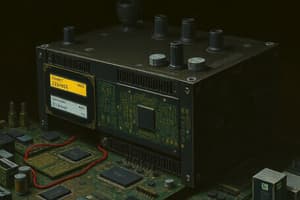Podcast
Questions and Answers
What distinguishes a Solid State Drive (SSD) from a Hard Disk Drive (HDD)?
What distinguishes a Solid State Drive (SSD) from a Hard Disk Drive (HDD)?
- SSDs have larger capacity but are slower than HDDs.
- SSDs have mechanical components, whereas HDDs do not.
- SSDs have lower power consumption and are faster than HDDs. (correct)
- SSDs use magnetic storage while HDDs use flash memory.
Which component is primarily responsible for managing data flow between the CPU, memory, and peripherals?
Which component is primarily responsible for managing data flow between the CPU, memory, and peripherals?
- RAM Slots
- CPU Socket
- Chipset (correct)
- I/O Ports
In terms of performance, which feature of a CPU allows it to handle multiple tasks simultaneously?
In terms of performance, which feature of a CPU allows it to handle multiple tasks simultaneously?
- Cache Memory
- Cores (correct)
- Clock Speed
- Instruction Set Architecture
When assessing RAM's contribution to system performance, which characteristic is NOT a defining feature?
When assessing RAM's contribution to system performance, which characteristic is NOT a defining feature?
What is a notable difference between integrated GPUs and dedicated GPUs?
What is a notable difference between integrated GPUs and dedicated GPUs?
Flashcards
Motherboard function
Motherboard function
The primary circuit board connecting all computer components.
HDD storage
HDD storage
Magnetic storage, large capacity, slower speed, mechanical parts.
CPU Cores
CPU Cores
Multiple processing units for parallel tasks.
RAM Types
RAM Types
Signup and view all the flashcards
GPU function
GPU function
Signup and view all the flashcards
Study Notes
Motherboard
- Definition: The main printed circuit board (PCB) in a computer that connects all components.
- Key Components:
- CPU Socket: Holds the processor.
- RAM Slots: Connects memory modules.
- Expansion Slots: For additional components like GPUs.
- Chipset: Manages data flow between CPU, memory, and peripherals.
- Power Connectors: Supply power to the motherboard and components.
- I/O Ports: Connect external devices (USB, HDMI, etc.).
Storage Devices
- Types:
- Hard Disk Drive (HDD):
- Magnetic storage, larger capacity, slower speed.
- Mechanical components (spinning disks).
- Solid State Drive (SSD):
- Flash memory, faster access speeds, more durable.
- No moving parts, lower power consumption.
- Hard Disk Drive (HDD):
- Form Factors:
- 2.5 inch (common for laptops), M.2 (compact and high-speed), PCIe (for high-performance applications).
CPU (Central Processing Unit)
- Function: The brain of the computer, executing instructions from programs.
- Key Features:
- Cores: Multiple cores allow for parallel processing.
- Clock Speed: Measured in GHz, indicates processing speed.
- Cache Memory: Small, fast memory for frequently accessed data.
- Instruction Set Architecture (ISA): Defines how a CPU processes commands.
RAM (Random Access Memory)
- Definition: Volatile memory used for temporary storage while a computer is running.
- Key Features:
- Types:
- DDR (Double Data Rate), with versions like DDR3, DDR4, DDR5.
- Capacity: Measured in GB (gigabytes), affects multitasking capability.
- Speed: Measured in MHz, impacts overall system performance.
- Types:
GPU (Graphics Processing Unit)
- Function: Specialized processor for rendering images, video, and animations.
- Types:
- Integrated GPU: Built into the CPU, suitable for basic tasks.
- Dedicated GPU: Separate card, better performance for gaming and graphic design.
- Key Features:
- VRAM (Video RAM): Memory dedicated to graphics data.
- CUDA Cores/Stream Processors: Parallel processing units for handling multiple tasks.
- APIs: Interfaces such as DirectX and OpenGL for graphics rendering.
Motherboard
- Acts as the primary printed circuit board (PCB) connecting all computer components.
- CPU Socket: Designed to hold the processor securely.
- RAM Slots: Facilitate connection of memory modules for data storage.
- Expansion Slots: Allow for installation of additional components, such as graphics processing units (GPUs).
- Chipset: Plays a critical role in managing data flow between the CPU, memory, and other peripherals.
- Power Connectors: Provide necessary power to the motherboard and connected components.
- I/O Ports: Enable connection of external devices such as USB drives and HDMI cables.
Storage Devices
- Hard Disk Drive (HDD):
- Utilizes magnetic storage technology; offers larger storage capacities but slower read/write speeds due to mechanical components (spinning disks).
- Solid State Drive (SSD):
- Employs flash memory for faster data access and enhanced durability; lacks moving parts, resulting in lower power usage.
- Form Factors:
- 2.5 inch: Commonly used in laptops.
- M.2: Compact design tailored for high-speed performance.
- PCIe: Optimized for high-performance applications.
CPU (Central Processing Unit)
- Acts as the central brain of the computer, executing program instructions.
- Cores: Having multiple cores enables parallel processing, enhancing performance.
- Clock Speed: Measured in GHz; a higher clock speed indicates a faster processing capability.
- Cache Memory: Small and rapid memory used for frequently accessed data to speed up performance.
- Instruction Set Architecture (ISA): Specifies the commands a CPU can process, influencing software compatibility.
RAM (Random Access Memory)
- Serves as volatile memory for temporary data storage during computer operation.
- Types:
- DDR (Double Data Rate) variants include DDR3, DDR4, and DDR5, each offering improvements in speed and efficiency.
- Capacity: Measured in gigabytes (GB); larger capacities improve multitasking capabilities.
- Speed: Measured in megahertz (MHz); affects overall system performance and responsiveness.
GPU (Graphics Processing Unit)
- Specialized for rendering graphics, video processing, and animations.
- Integrated GPU: Built into the CPU, sufficient for basic tasks and less resource-intensive applications.
- Dedicated GPU: Independent graphics card, delivering superior performance for gaming and graphic design needs.
- Key Features:
- VRAM (Video RAM): Specialized memory allocated for graphic data storage and processing.
- CUDA Cores/Stream Processors: Units designed for parallel processing, enabling efficient multitasking in graphics rendering.
- APIs: Graphics rendering interfaces such as DirectX and OpenGL facilitate the development of graphic-intensive applications.
Studying That Suits You
Use AI to generate personalized quizzes and flashcards to suit your learning preferences.




